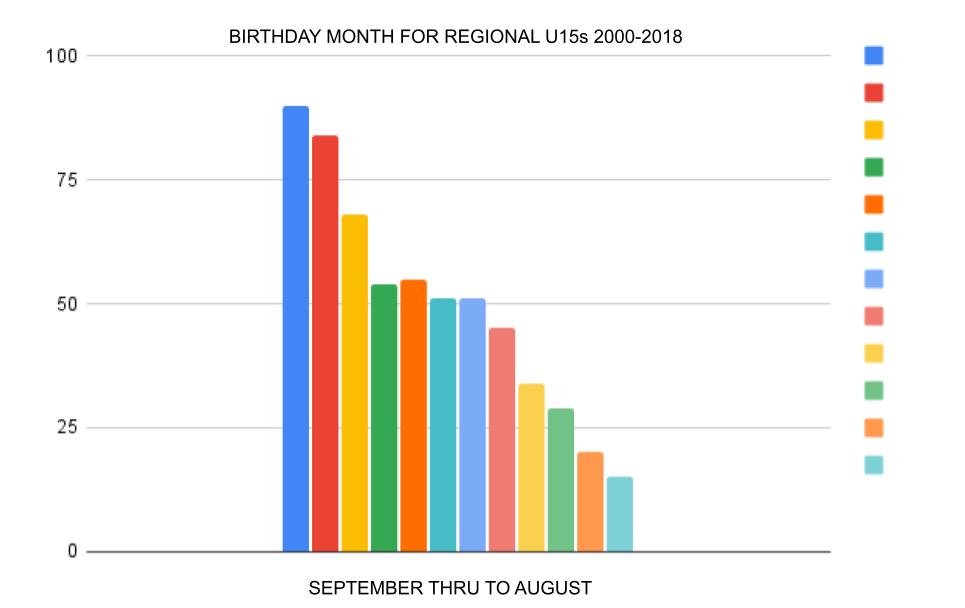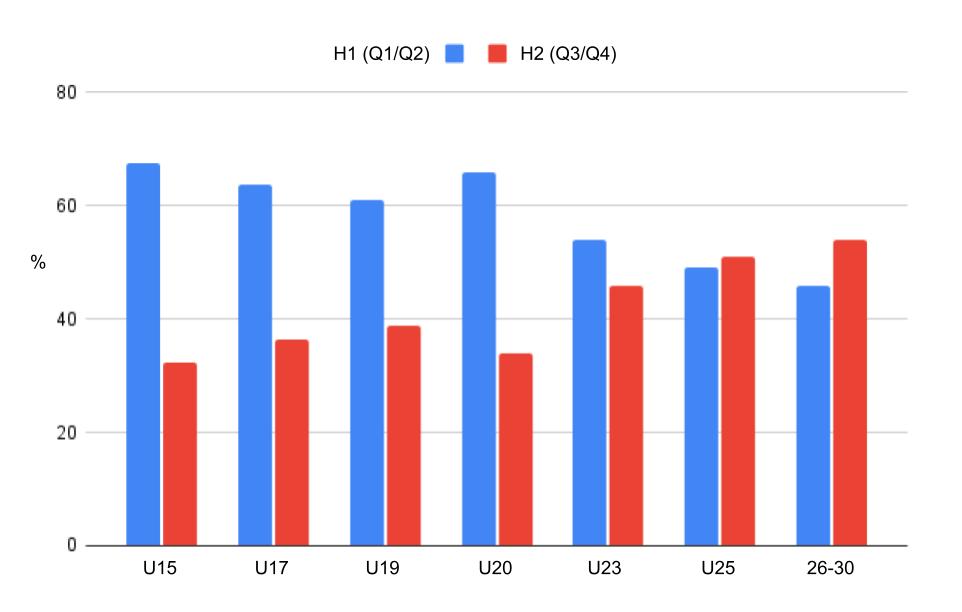10 Relative Age Effect (RAE) Myths
Background: What is Relative Age Effect? What are Birth Quarters?
1. This is just about Q1s and Q4s
Q2 and Q3 are important too! In cricket there tends to be a difference between Q1/Q2 and Q3/Q4 (also known as H1 and H2 for Half-Year). For example the Birth Quarter percentages for the last 4 England U19 World Cups are 34.5, 36.2, 15.5 & 13.8 (H1 70.7, H2 29.3). Or at a younger age group the values are 37.8, 25.9, 21.2 & 15.1 (H1 63.7, H2 36.3) for the Regional U17s (Super 4s).
There is also a linear effect by month, e.g. in the Bunbury (Regional U15s) competition over the last 19 years.

2. At 18+ Relative Age Effect is no longer an issue
As you can see from the graph below, for players on a national pathway that continue into professional county cricket, RAE declines very slowly! It is not until players are 24/25 that RAE disappears. Interestingly for the age band 25-30, when players are typically ‘at their best’ there is a genuine RAE Reversal.

3. Relative Age Effect is the biggest bias in Player Identification
RAE can cause an inter-player difference of up to 1 year whereas Maturation variation can be up to 5 years. In addition it is when a player goes through the growth spurt that differences in strength, power, endurance and speed can really come to the fore. The impact from Maturation over RAE has been estimated as being 10x more influential on selections.
Is Maturation currently the biggest unaddressed issue in Player ID & Development in English Cricket?
4. Maturation evens Relative Age Effect out
a. As we can see from the graph above RAE doesn’t ‘even out’ until age 24/25 for county professionals.
b. Maturation effects and RAEs are two completely different constructs! A Q4 can be an early maturer. A Q1 can be a late maturer. Equally a Q1 can be an early maturer (most advantage for continued selection in the current system) and a Q4 can be a late maturer (most disadvantage for continued selection in the current system). So RAE and Maturation don’t even each other out. They can work both in the same direction as well as in opposite directions, and at different strengths of effect.
5. Relative Age Effect due to strength/power advantages
Older players have been around longer. More growing time, more cognitive, emotional and social development. They will have had more training, more game time and hence more experience. Research has shown that physical strength, power, endurance and speed are more likely to be influential only once the growth spurt starts.
6. Relative Age Effect is getting better
Data from 19 seasons of Regional U15s (Bunbury), 7 years of Regional U17s (Super 4s), 22 years of England U19 World Cup squads shows that RAE is NOT getting better and in some recent years has got worse.
7. Our region is better than other regions at Relative Age Effect
From the table below we can see that for Regional U15s (Bunbury) there is some regional deviation but ALL have significant RAE (Data from 2000-2018).

8. Addressing Relative Age Effect would cause the loss of the Underdog Effect
Background: What is the Underdog Effect?
Really? Even if there were a 25%x4 representation of all 4 Birth Quarters there would still be a ‘Q4 effect’. Every Q4 would be up against 3 older players. Perhaps Player Development Environments should be better at creating an optimal challenge point for all individuals, especially the under challenged Q1s and Q2s, rather than just relying on inherent player ratios? Also maybe a reason why Q4 conversion rates are higher than other Birth Quarters is due to other factors than just the constant underdog challenge? Perhaps there is a Selection Concentration Effect?
9. Education alone will fix this
Even when coaches were aware of RAE and had the BQ data in front of them while conducting a trial, there was still RAE. Only when the players wore numbered bibs in age order did selections remove RAE. Coaches made their judgements ‘in context’ evaluating players performances in U11 football in Holland (Mann & Ginneken, 2017).
Education can help especially if it is targeted at ALL coaches. Most club coaches are L1 or 2. ECB coach education should include RAE education on these courses or at least make a separate module/online video resource.
10. ‘Just a function of the calendar’ - there are no solutions
One solution would be the use of Age Ordered Bibs for all trials. This would be cheap and easy to implement. Often numbered bibs are used already. A number of potential other solutions exist too.
This IS ‘merely’ a function of the calendar. It IS an ‘administrative’ problem. It IS possible to adopt different or at least amended ‘administrative’ solutions. For example, New Zealand are implementing ‘weight categorizations’ and French Rugby are researching this too to avoid the obvious failings of simple chronological age grouping.